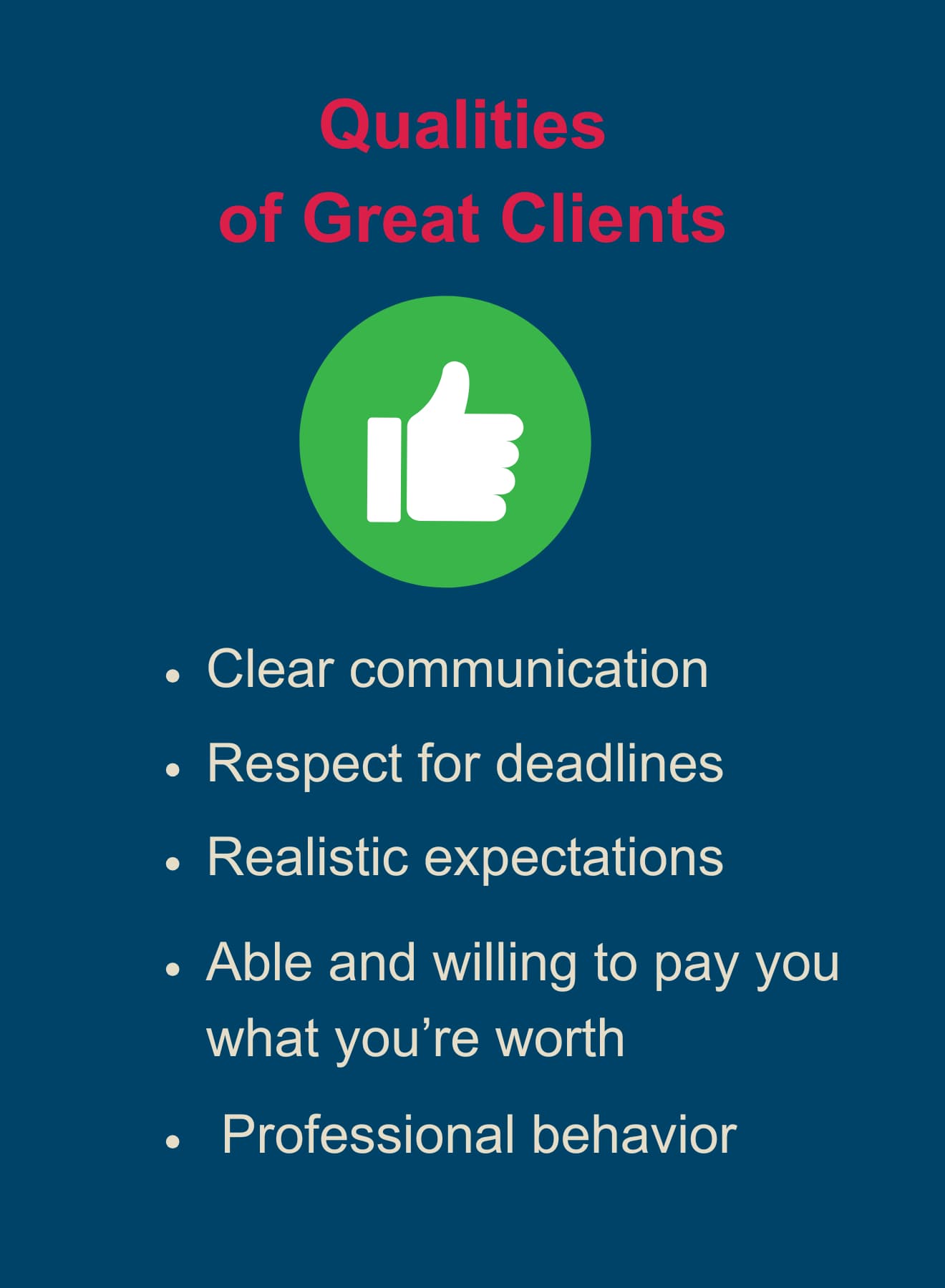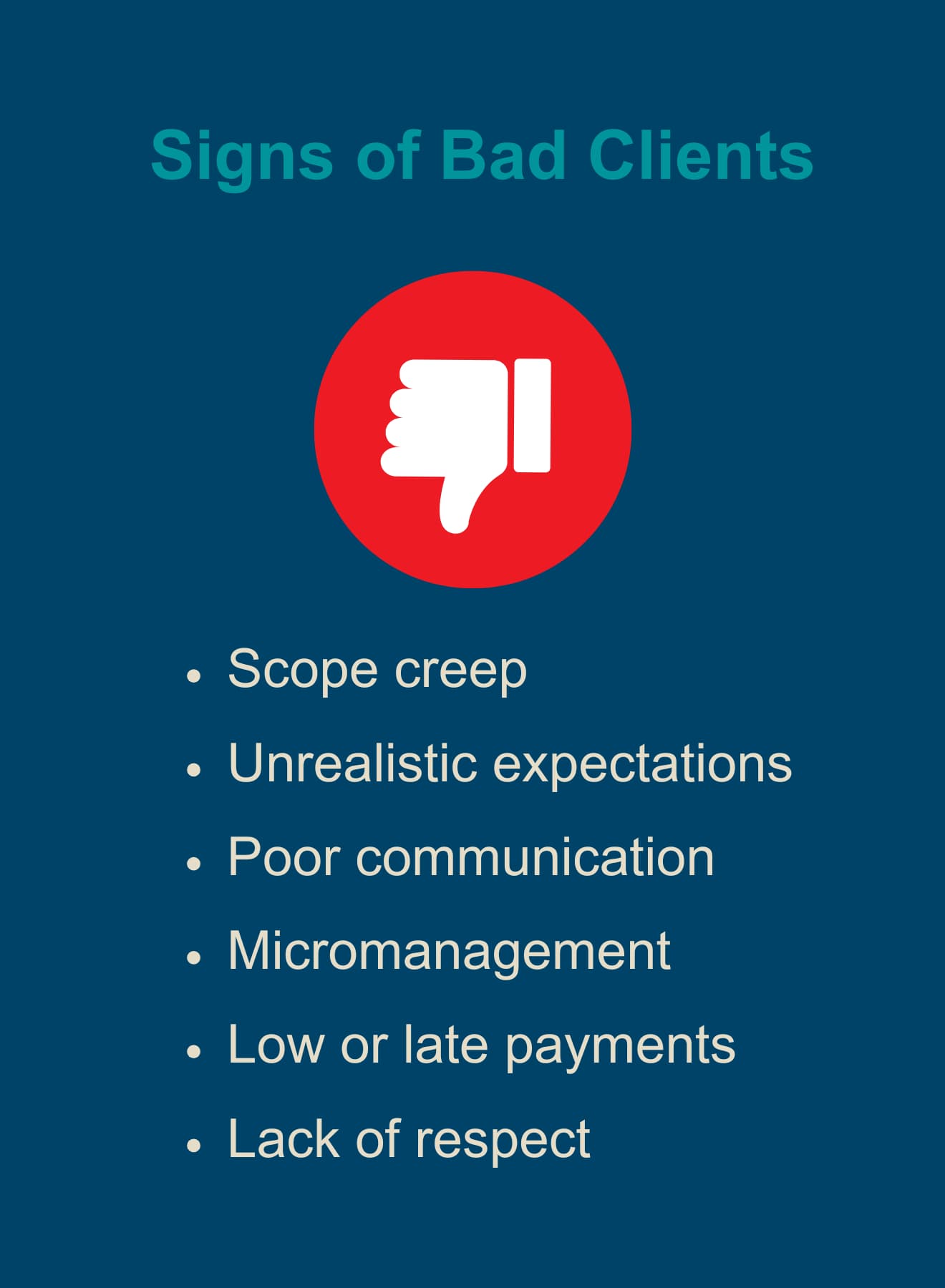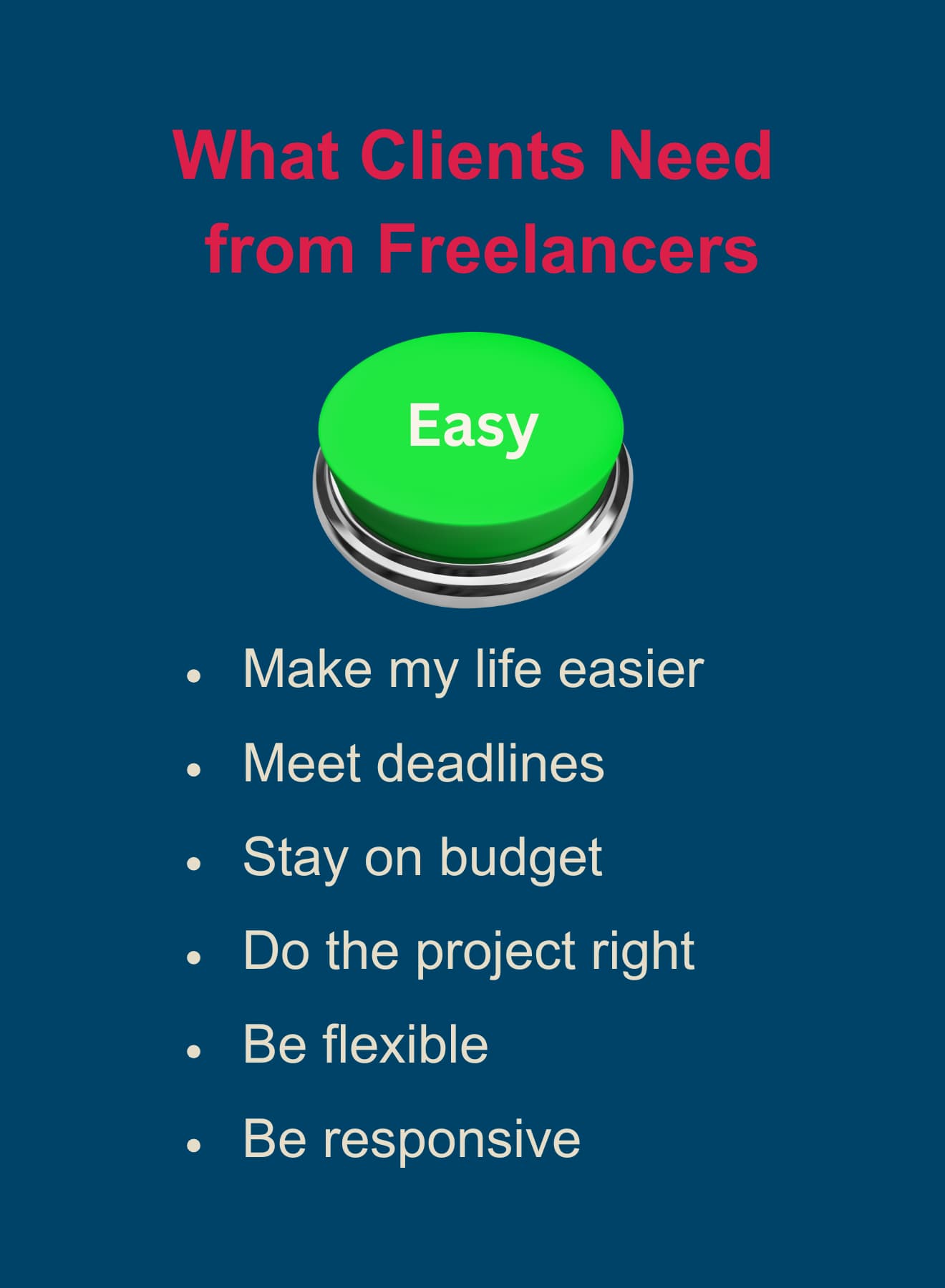Less Stress, More Success: How to Find Great Clients

We all want—and deserve—to work with great clients who pay us what we’re worth, value our work and treat us right. Here’s how to identify great clients, avoid bad clients, and get the great clients you deserve.
Each year, I write dozens of articles about clinical research for one of my clients. They have always been happy to pay my rate, have reasonable deadlines, and are nice people to work with. Most, but not all, of the work is interesting. And it’s virtually stress free. We’ve been working together since 1999—two years after I started my freelance business.
Working with great clients like this energizes and inspires freelancers. And if you’re a new freelancer, it also boosts your confidence.
Great Clients Need Your Help
Great clients who need the help of talented freelancers are out there. These clients pay you what you’re worth, give you steady and interesting freelance work, and treat you right. When you work with them, you’ll do your best work.
Unfortunately, bad clients are out there too. These clients drain your energy, increase your stress, and leave you feeling frustrated.
But once you know the qualities of great clients and the signs of bad clients—and that you can get the great clients you deserve—it’s much easier to find great clients and avoid or fire bad clients.
Qualities of Great Clients
Great clients share some common qualities.

Clear communication
A great client can explain what they need to you. They provide detailed instructions, clear objectives, and the background information you need. They answer your questions promptly.
Sometimes the client isn’t quite sure what they need. That’s okay as long as they’re willing to work with you to figure this out before you start working on the project.
Great clients give you constructive feedback on your work.
Respect for deadlines
Respect for deadlines means that the client does what they need to do so you can complete the project by your deadline. A client who values deadlines will:
- Respond to your emails or phone calls promptly
- Stick to agreed-upon schedules without last-minute changes.
Realistic expectations
A great client understands what’s reasonable within the project’s timeline, budget, and scope. They won’t expect you to cram a week’s worth of work into one day or to work over the weekend to complete their project. A client with realistic expectations also:
- Doesn’t expect the first draft to be perfect
- Understands the difference between meeting a tight deadline and rushing to complete the project, which results in poor quality.
Professional behavior
When clients behave professionally, they foster trust, productivity, and mutual respect—and enable you to do your best work for them. A great client is honest and transparent about:
- Project goals and expectations, and what success looks like
- Potential challenges that they or you may experience, such as tight budgets or competing priorities.
Also, if something’s not working, they explain why instead of leaving you to guess about what’s wrong.
Able and willing to pay you what you’re worth
A great client understands the value of freelance help and is willing and able to pay you the market rate for your work. They:
- Will discuss the budget from the start
- Won’t offer you a ridiculously low fee
- Will pay you on time.
Signs of Bad Clients
Bad clients stand out for all the wrong reasons. The signs of bad clients are mostly the opposite of the qualities of great clients.

Scope creep
Scope creep—when clients add to a project without adjusting the deadline or the payment—is very common in freelancing. While some projects will change, the client should always extend the deadline and increase the payment when this is necessary.
Unrealistic expectations
Sometimes, clients expect too much of freelancers. They may want you to get the work done in an unrealistic timeline or do too much work for the fee. Or they may expect you to be available to them outside of your work hours.
Poor communication
If clients don’t clearly explain what they need, send you the background information for the project, and answer your questions promptly, you can’t complete the project. Poor communication also includes constantly bombarding you with often confusing messages.
Micromanagement
As long as we meet our deadlines and other project requirements (e.g., attending specified meetings) and do great work, freelancers can work on projects when and how we want to. But some clients try to tell us what to do and when to do it.
Low or late payments
Clients who pay badly usually treat freelancers badly. Late payment and questioning the agreed-upon rates or terms, are other payment problems.
Lack of respect
Many of the other signs of bad clients come from a lack of respect, which also includes:
- Talking down to us
- Expecting us to be on time for meetings but coming late themselves
- Expecting immediate responses, especially outside of agreed-upon work hours
- Ignoring our professional opinion
- Being rude or abusive.
Trust your instincts
Always trust your instincts. If you’re not sure whether a client is bad, or you just need someone to confirm that the client is bad, ask your freelance friends what they think.
Decide What Great Clients Means for You
Few clients are great in every way. Trade-offs in working with different types of clients include:
- Bigger clients can pay you more, but it may take longer to get paid.
- Some clients may pay well and fast, but have rigid project guidelines.
- Clients that pay the best may have the tightest deadlines.
Decide which qualities of great clients and which signs of bad clients matter most to you. Considerations include the stage of your freelance business, your financial needs, and your personal preferences.
If you’re a newer freelancer, you’ll probably need to accept some things you wouldn’t accept once you’ve built a stable, successful freelance business. For example, you’re not likely to make the highest end of market rates for the work you do. But the payment should still be reasonable.
Once I consistently had as much work as I wanted, I only worked with clients who treated me right and paid me market rates. But some of my clients (hospitals and some healthcare communication agencies), pay all vendors late, usually between 45 and 60 days. I’m okay with this because I know that I will be paid and I won’t have to follow up.
You Can Get the Great Clients You Deserve
Many freelancers take whatever work comes along. This work is usually for clients who underpay and overwork them—bad clients.
Why does this happen? Because many freelancers don’t know how to get the clients they deserve.
It doesn’t have to be that way. If you focus on two things you can great clients:
- What clients need and how you can meet their needs
- What works best in marketing a freelance business.
What Clients Need
When you focus on what your clients need, they see that you’re great you are at what you do. And they see how working with you benefits them.
Because you’re showing clients how you can help them, your marketing won’t be pushy or sleazy. But it will be professional and comfortable. I call this client-focused marketing.
Figuring this out what great clients need isn’t as hard as you probably think it is. Clients have 3 types of needs:
- General
- Freelancer-specific
- Target market or company-specific.
Common general client needs include:
- Get more business (usually by selling more products or services)
- Make more money (also by selling more products or services but the language you’ll use to attract these clients may be somewhat different)
- Help their clients build their businesses
- Be seen as a thought leader
- Educate and inform people
- Stay on budget and on deadline.
Freelancer-specific needs start with working with freelancers who are excellent at what they do (writing, editing, etc.). You don’t always need experience in the type of work the client is looking for help with, but you do need to have experience that’s relevant to the type of work or the client’s industry.
Making the client’s life easier is the key overall need of all clients. Here are other things that clients need from freelancers.

Professional associations and industry news are the best way to learn about target market needs. Research on a prospect’s website is the best way to learn about company-specific needs.
Learn more about client needs
How to Get Your Ideal Freelance Clients
What Works Best in Getting Great Clients
Three things work best in marketing a freelance business:
- Networking
- Direct email.
This is based on my survey How Freelancers Market Their Services: 2025 Survey: Results Report and my work with hundreds of freelancers through Finding the Freelance Clients You Deserve.
How to get great clients on LinkedIn
More and more clients are searching for freelancers on LinkedIn. And when clients meet or hear about you, they want to check you out, usually on LinkedIn, before contacting you about freelance work. Colleagues also want to check you out before they refer work to you.
To get steady, high-paying freelance clients on LinkedIn, you need to:
- Develop a complete, compelling, client-focused profile
- Build a big relevant network (500+)
- Be active.
How to get great clients with networking
Who you know—your network—can be more important than anything else in getting high-paying freelance clients.
That’s because clients want to do business with freelancers they know and trust—or freelancers that someone they know and trust referred to them. And it’s not as easy as you probably think it is for them to find competent, dependable freelancers.
Building a trusting, strategic network will help you:
- Get more referrals
- Meet more clients
- Get practical advice and support from other freelancers.
How to get great clients using direct email
Direct email frees you from low-paying, high-competition freelance jobs sites and content mills and taking whatever work comes along.
When you use direct email well, you make yourself irresistible to steady, high-paying clients. You do this by carefully customizing each email to the client and focusing on how you can help the client.
Also, you learn more about the clients you want to work with. This will help you become the expert that great clients are looking for when they hire a freelancer.
Get tips on how to use networking, LinkedIn, and direct email to get the clients you deserve
3 Easy Ways to Get the Freelance Clients You Deserve in 2025
Ready to Fire Bad Clients?
Now that you know the qualities of great clients and the signs of bad clients—and that you can get the great clients you deserve—it’s time to start finding those clients. Update your LinkedIn profile and website to appeal to the clients you want to work with. Then, review your client list. Decide which clients you shouldn’t be working with. Fire them. Use LinkedIn, networking, and direct email to replace bad clients with the great clients you deserve.
Learn how to fire bad clients
Breaking Free: A Freelancer’s Guide to Firing Bad Clients
Learn More About Getting Great Clients
Content from The Mighty Marketer
How to Use a Red Velvet Rope to Get Your Ideal Clients
Breaking Free: A Freelancer’s Guide to Firing Bad Clients
3 Easy Ways to Get the Freelance Clients You Deserve in 2025
How to Get Your Ideal Freelance Clients
10 Steps to Your Freelance Success: The Ultimate Guide
How Freelancers Market Their Services: 2025 Survey: Results Report